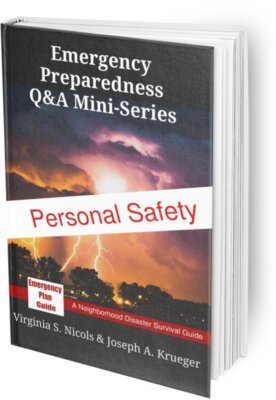
Those of us with a built-in “readiness outlook” tend to want to help others to enjoy the same advantages. It’s not just having a working flashlight when the power goes out. The real advantage is attitude: feeling you’re aware of what’s happening and confident you can handle it!
Who better to be talking with about being confident than young people leaving home for the first time, heading off to college?
Last weekend I had that opportunity. I was invited to put together an online discussion for a local group of high-school-aged Girl Scouts. It was part of a series on getting ready for college. (They had already had sessions on test taking, finances, etc. and next up is a session on coping with negative emotions, depression, etc.)
What a pleasure it was to speak to the group! (Most kept their video feed off, by the way.)
I invite you to share this Advisory – and if you have a group of girls (or guys, for that matter) who might like to talk about this topic, we could make it happen!
Off to College: Girl’s Guide to Safety and Security on Campus
The challenge: college will expose students to new experiences and the need to make decisions they may never had to make before. Our goal is to help students:
- avoid really dangerous mistakes
- recognize when they’re headed in the wrong direction
- use new skills to get straightened out and back on track.

Here are some of the potential dangers we looked at, and the tools and skills available to girls as they make decisions about where to go to college.
What dangers could the weather bring?
First we addressed impersonal challenges.
I’m here in Southern California, as were my audience members. We don’t have hurricanes. We don’t get snow. We don’t get tornados. So, those students heading off to school in the Midwest, the East Coast, and maybe even Hawaii need to do some research on the chances of their school being hit by a natural disaster! Even “non-disaster” weather might result in a power outage, need to shelter-in-place, or to evacuate. (Emergency kit ready?) Certainly, students may need some new clothes!
Weather research is easily done – but do it before you go!
Be prepared for new living conditions.
After weather, we started in on personal situations that have the potential of becoming emergencies or even disasters.
No matter whether it’s a high-rise dorm or an apartment, be sure you know how to escape in an emergency. Where are stairs, back doors, fire extinguishers, etc.? Take a tour!
Are you ready to take care of your health – without a parent’s reminders? This involves what you eat, how much sleep you get, how you care for your “stuff” (doing the laundry on your own, maintain a car, etc.) For perhaps the first time you will be making all these decision on your own. Learn what you need to know before you leave home!. (The stories about students not being able to do their own laundry seem terribly common!)
Are you ready to deal with a roommate – or several of them?
There’s an art to living with strangers – and a lot of it has to do with open communication about setting boundaries. Freshmen need to be ready to talk with roommates about all sorts of issues they may never have dealt with before, like:
- routines (sleeping, cleaning)
- privacy (and this includes digital privacy)
- visitors including overnight visitors
- security (locking room, lending computers or cars, etc.)
My own research on security stressed two things: 1. Find out what recommendations the school makes 2. KEEP YOUR DOOR LOCKED. (You may even want to invest in a wedge for the door or an alarm for the door knob.)

Be smart and be ready for new social situations.
This was, of course, the most interesting part of the discussion. (We even had a parent in the group, and she was particularly concerned.)
Of course, there are many areas to cover, but here is some of what we talked about:
- Don’t find yourself alone in the wrong place. Your homework and discussions with campus security should reveal how best to get around, where not to be in the dark, etc.
- Be aware that even in a group – such as at a demonstration – you may need to protect yourself and/or take evasive measures.
- Should you consider carrying a weapon? Something like pepper spray? Every campus is different, every state is different in what’s legal.
- What about parties?! Enjoy them! But go with a group, and come home with your group. Manage your drinking (know beforehand how much you can handle), guard your cup, be prepared to say no.
- Know your own responses and boundaries when it comes to drinking, drugs, physical attention, and peer pressure.
Setting boundaries takes thought and even practice beforehand.
As part of my preparation I interviewed several students now in their second year of college. They all emphasized that a student must be ready to immediately and strongly make it clear when someone is getting too close or too intimate. Let them know you don’t allow that behavior!
(“But what exactly do I say?” I developed a worksheet with sample boundary statements. See the link below.)
Avoid the one activity that makes you more vulnerable than any other.
You must know what that is by now! It’s being buried in your cellphone! We talked about the concept of situational awareness. The rule: “Heads up! Phones down!”
In summary . . .
Our discussion really revolved around three important preparedness activities that girls heading for college can engage in:
- Do more homework about potential colleges! It’s not just a question of size, reputation, etc. Go online and dig out more info about weather, security recommendations, campus policies, etc.
- When you arrive, tap into face-to-face resources: your dorm assistant, campus security, others with your similar interests and values, etc.
- Pay attention to what’s going on around you, and be ready to take action when necessary. Don’t be afraid to look silly or to make a scene!
And what more can I recommend with regards to personal safety?
I already mentioned the Setting Boundaries worksheet. It is accompanied by a list of what a student might want in a Campus Emergency Kit. Download both worksheets here.
A serious discussion about personal safety really deserves more than just this one Advisory. The 17 questions in our mini-series Personal Safety booklet cover many of these subjects in much more detail – and make you think a bit harder. In particular, the booklet deals with questions about alarms, self-defense, pepper spray and tear gas (including legal restrictions), and deadly weapons. It asks some questions, too, about how you might feel after having used them.
Though not written specifically for students, any college-bound young person can use the information in this booklet. Get a copy for high-schoolers you know, and a copy for their advisors, too!

Easy to download, easy to read. Kindle version or paperback, whichever works best for you. Here’s the direct link to Personal Safety at Amazon.
Virginia
Your Emergency Plan Guide team
P.S. Dealing with young people about emergency preparedness was refreshing and a real change of pace for me. I’d love to do it again.
So I repeat my invitation: if you know a group of kids, particularly teen-agers, think about our getting together via Zoom to talk about some of these ideas. The adults might learn something new (I did, in my interviews!). And the young people may become engaged in a new way, too. Just drop me a line to get the conversation started.
Don't miss a single Advisory.
Thank you for subscribing.
Something went wrong.
